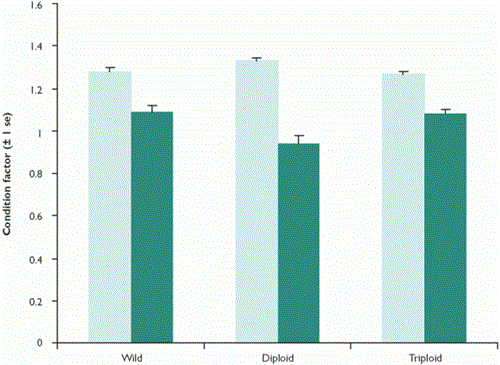Key findings
- Farm-reared female triploid trout did not make any concerted movement into the spawning grounds and were not observed interfering with wild spawning or consuming wild trout eggs.
- Farm-reared female triploid trout showed higher survival and maintenance of condition than farm-reared female diploids over the winter.
- Farm-reared female diploid trout undertook spawning migrations and were seen spawning, almost certainly with wild trout.
In a previous Review we described one component, an angler perception survey, of our recent investigation into the success and effects of triploid (infertile) and diploid (fertile) brown trout stocking. The use of infertile fish for stocking removes any risk of interbreeding between farm-reared and wild fish, thereby maintaining the genetic fitness of wild stocks. We have undertaken our investigation in partnership with the Environment Agency and our findings will help to guide its National Trout and Grayling Fisheries Strategy.
We are now able to present the findings from another component, a radio-tracking study undertaken on the River Allen, Dorset. The aims of this study were to establish the distribution of three types of female trout during the winter spawning period: a. wild, b. farm-reared diploid and c. farm-reared triploid brown trout, to observe behaviour and to record the over-winter survival and condition of the three groups.
This study was prompted by concerns that farm-reared triploid trout would follow wild trout onto spawning grounds and, once there, disrupt their activity thereby affecting spawning success and subsequent recruitment. Concern has also been raised that if triploids enter spawning grounds they may either actively (by excavating redds) or passively (by drift feeding) consume the eggs of wild trout.
We began work in September 2005 and finished in March 2007, which covered two winter spawning periods. In each winter, we surgically implanted 20 female farmreared diploid, 20 female farm-reared triploid and 20 female resident wild brown trout adults with radio transmitters (weight: 3.5g; volume: 1.4cm3) and released or returned into adult habitat (deep, vegetated glides) immediately downstream of good spawning grounds (shallow, fast-flowing and gravelly riffles).
We tracked the fish on foot twice-weekly over the winter to establish their distribution. We also employed fixed listening stations in key areas to monitor fish movements between spells of tracking.
The main spawning window on the River Allen occurred between the middle of November and the middle of January. The female triploid trout group displayed no clear migratory movements into the spawning areas and we found no evidence of triploid trout interfering with wild trout spawning. However, most of the farm-reared female diploid trout and the female wild brown trout spawned.
Members of the farm reared diploid group must have spawned with wild males as only female farm-reared trout have been stocked in the study river in recent history and the only fish farm in the area produces just females. We recorded no evidence of predation of wild brown trout eggs by farm-reared female diploid or triploid trout.
The female diploid group began spawning earlier than the female wild brown trout group in one year and later in the other although there was overlap in both years. In the first study year, triploids appeared to be slightly more susceptible than the other groups to displacement during an isolated period of very high flow. Overall mortality (most of which was attributed to predation) was lowest in the female triploid group, with 53% surviving over the winter compared with 31% of wild females and 30% of female diploids, suggesting an increased vulnerability to predation during spawning activity.
Overall, despite female farm-reared diploids being in slightly better condition at the time of stocking, they were in significantly worse condition than the other two groups at the end of the spawning period (see Figure 1). The condition of triploids at the end of the spawning period was better than that of diploids due to the latter having spawned. We believe that the loss of condition of wild trout was because of spawning, whereas the loss of condition of triploid trout was because of their farm-reared origin and the significant loss of condition of the diploid trout was due to a combination of these factors.
Figure 1: Comparison of mean initial and final condition factors of radio-tagged wild diploid and triploid brown trout

Notes: condition factor (K = 100,000 W / L3, where W = fish weight in grams and L= fish length in millimetres) of radio-tagged wild: n = 40; 11 respectively; diploid: n = 40; 12; triploid brown trout: n = 40; 21. Both years pooled.